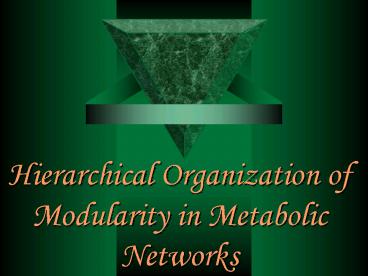Hierarchical Organization of Modularity in Metabolic Networks - PowerPoint PPT Presentation
1 / 39
Title:
Hierarchical Organization of Modularity in Metabolic Networks
Description:
Spatially or chemically isolated functional modules composed of several cellular. components and carrying discrete functions are ... Life's. Complexity Pyramid ... – PowerPoint PPT presentation
Number of Views:34
Avg rating:3.0/5.0
Title: Hierarchical Organization of Modularity in Metabolic Networks
1
- Hierarchical Organization of Modularity in
Metabolic Networks
2
? ? ??? ??? Dong W ZhangXX
Wang XY
3
3MsMetabolic networksModuleModularity
4
Spatially or chemically isolated functional
modules composed of several cellularcomponents
and carrying discrete functions are considered
fundamental build-ing blocks of cellular
organization.
5
3MsMetabolic networksModuleModularity
6
The concept of modularity assumes that cellular
functionality can be seamlessly partitioned into
a collection of modules.
7
small, highly connected topologic modules
combine hierarchically
- larger, less cohesive units
8
Within Escherichia coli ,the uncovered
hierarchical modularity closely overlaps with
known metabolic functions. The identified network
architecture may be generic to system-level
cellular organization.
9
The probability that a substrate can react with k
other substrates the degree distribution P(k) of
a metabolic network decays as a power law P(k)
k r with r2.2 in all organisms.
Metabolic networks have a scale-free topology.
10
Featureexistence of a few highly connected
nodes (e.g., pyruvate or coenzyme A), which
participate in a very large number of metabolic
reactions.
11
Fig.1. Complex network models
12
Scale-free model
left
right.
13
In such a network,a few highly connected nodes,
or hubs (blue circles),play an important role in
keeping the whole network together.
14
A typical configuration of a scale-free
network with 256 nodes is also shown,obtained
using the scale-free model,which requires the
addition of a new node at each time such that
existing nodes with higher degrees of
connectivity have a higher chance of being linked
to the new nodes.
15
Albert-László Barabási,
Réka Albert
Science 286,509(1999)
Emergence of Scaling in
Random Networks
16
A common property of many large networks is
that the vertex connectivities follow a
scale-free power-law distribution.
?) networks expand continuously by the addition
of new vertices ?) new vertices attach
preferentially to sites that are already well
connected.
17
Scale-free model
left
right
18
E. coli high clustering coefficient
Modular organization
Modules of varing size connected by few links
Most nodes have approximately the same number of
links,which contrasts with the scale-free
nature.
19
Modular model
20
How to determine whether such a dichotomy is a
generic property of all metabolic networks?
21
- Calculate the average clustering coefficient
for 43 organisms
Ci2n/ki (ki-1)
Ci averaged over all nodes i of a metabolic
network is a measure of the networks potential
modularity. And Ci is independent of their size.
22
(No Transcript)
23
Size-independent clustering coefficient
Modular model
24
Power law degree distribution
Scale-free model
25
The hierarchical model is proposed to resolve
this contradiction.
26
Hierarchical model
Hierarchical levels blue green red
27
The architecture of such a network integrates a
scale-free topology with an inherent modular
structure.It has a power law degree distribution
with degree exponent r1(In4)/(In3)2.26C0.6
(independent with the size)Whats more, in
agreement with the results of fig2B
28
A unique featurehierarchical architectureThe
higher a nodes connectivity, the smaller its
clustering coefficient, following the 1/k law
29
Lifes Complexity Pyramid
30
(No Transcript)
31
Whether such hierarchical organization is present
in cellular metabolism?
?
32
Measure the C(k) function for the metabolic
networks of all 43 organisms.(fig2 C-F) For each
organism, C(k) is well approximated by C(k) k 1.
33
How to uncover potential relations between
topological modularity and the functional
classification of different metabolites?
?
34
Focus on metabolic reactions of E.coli
- decrease its complexity without altering
- the network topology
- calculate the topological overlap matrix
- OT (i, j) of the condensed metabolic
- network. (fig3A)
35
36
OT(i, j) Jn(i, j)/min(ki,kj)
37
(No Transcript)
38
(No Transcript)
39
(No Transcript)
40
(No Transcript)
41
(No Transcript)
42
Thank You































